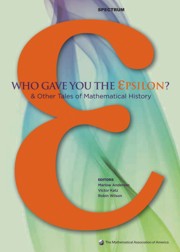Book contents
- Frontmatter
- Introduction
- Contents
- Analysis
- Geometry, Topology and Foundations
- Algebra and Number Theory
- Surveys
- Foreword
- The International Congress of Mathematicians
- A Popular Account of some New Fields of Thought in Mathematics
- A Half-century of Mathematics
- Mathematics at the Turn of the Millennium
- Afterword
- Index
- About the Editors
Afterword
from Surveys
- Frontmatter
- Introduction
- Contents
- Analysis
- Geometry, Topology and Foundations
- Algebra and Number Theory
- Surveys
- Foreword
- The International Congress of Mathematicians
- A Popular Account of some New Fields of Thought in Mathematics
- A Half-century of Mathematics
- Mathematics at the Turn of the Millennium
- Afterword
- Index
- About the Editors
Summary
G. B. Halsted names several mathematicians who participated in the Second International Congress, most of whom are not household names today. These include, first, the representatives of the U. S., Charlotte Angas Scott (1858–1931), from Bryn Mawr College [14] of Japan, Rikitaro Fujisawa (1861–1933); and of Spain, Zoel Garcia de Galdeano y Yanguas (1846–1924). The last of these was the academic advisor of Julio Rey Pastor, who later became the central figure in the development of mathematics in Argentina in the twentieth century. Then there were Halsted's “interesting personalities”. One of these was Samuel Dickstein (1851–1939), a Jew from Russian Poland who at the time of the Congress was the principal of a science-oriented secondary school in Warsaw that had introduced Hebrew into its curriculum and who later was one of the first professors of mathematics at the University of Warsaw. There were also Karl Gutzmer (1860–1924), a German mathematician who worked on differential equations; Emile Lemoine (1840–1912), a French civil engineer who did some work in geometry; Alessandro Padoa (1868–1937), an Italian logician who lectured on a new system of definitions for Euclidean geometry at the Congress; and Dmitrii Sintsov (1867–1946), who created a school of geometry at Kharkov University in Russia. One wonders what Halsted's criteria for “interesting personalities” were. (Biographies of most of the mathematicians Halsted mentions are available online at Wikipedia or at the St. Andrews MacTutor website.)
- Type
- Chapter
- Information
- Who Gave You the Epsilon?And Other Tales of Mathematical History, pp. 423 - 426Publisher: Mathematical Association of AmericaPrint publication year: 2009

